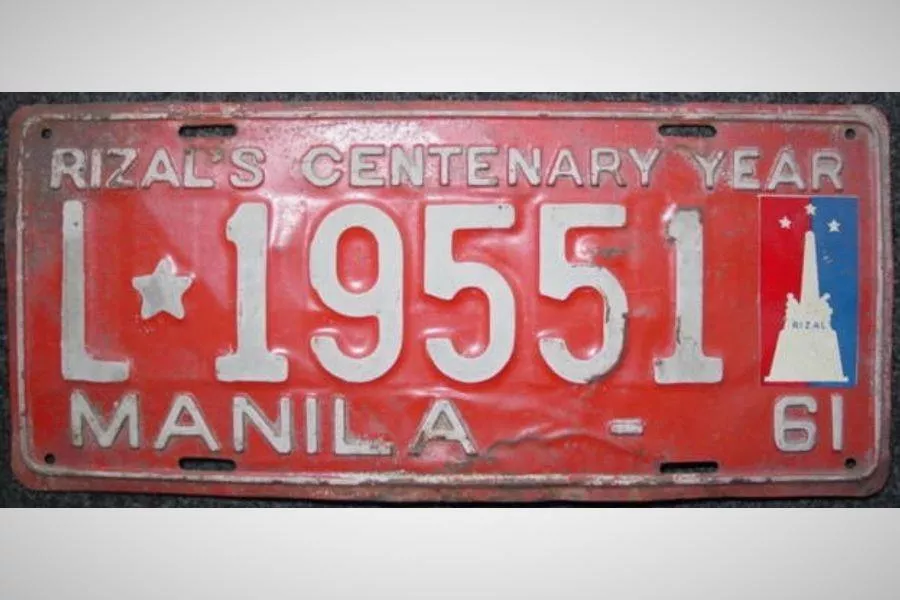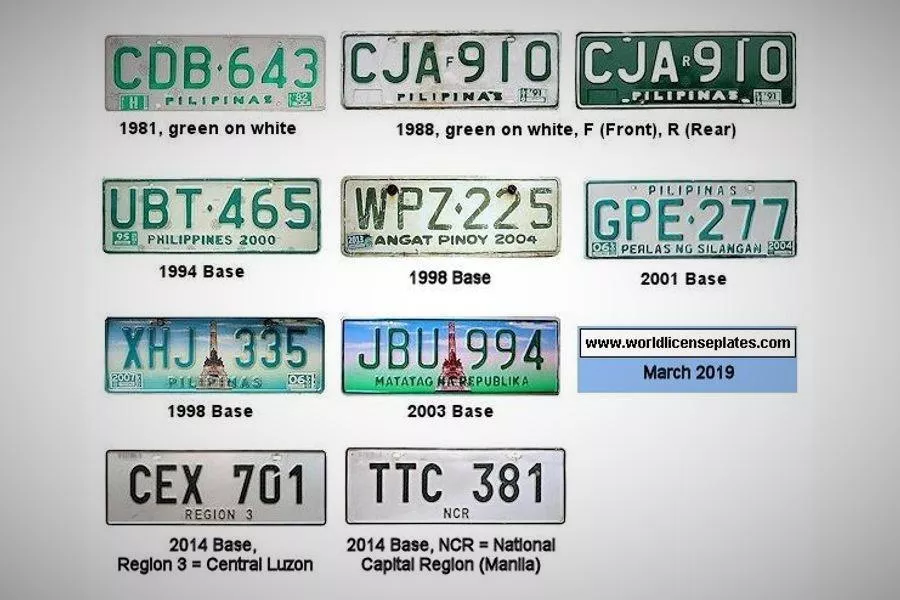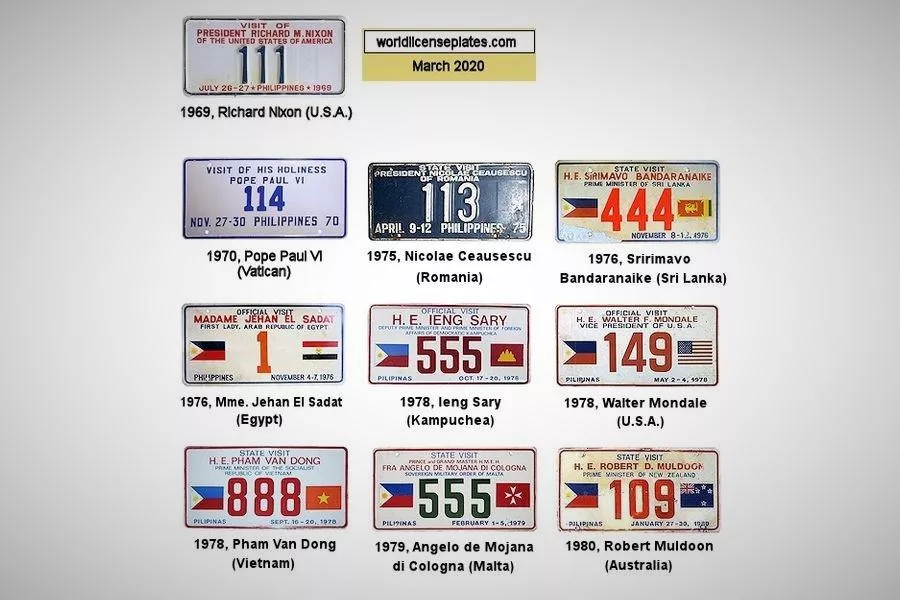The issue of license plates is still a sore point for many motorists today, but these metal tags at the ends of our cars remain part of local automotive history. As a unique identifier of vehicles on the road, license plates have played a major role in our country’s transport system.

License plates also have a history all their own
A distinguishing feature of license plates is their use of alphanumeric code, which has gone through a variety of combinations in the last six decades. While the major distinctions these days comprise private/public automobiles, government vehicles, and diplomatic cars, license plates were more varied in the 1960s.
1960s
The start of that decade saw white characters set against a green background, replaced by a new numbering format and color set in 1961. This was bannered by Rizal’s Centenary Year as the topmost line of text (commemorating a century from the national hero’s birth), with a decal on the right portion depicting the Rizal Monument. Year tabs were placed on the lower right corner.

Plates issued in 1961 commemorated the centenary of Jose Rizal's birth
Varying color combinations were used depending on the type of vehicle, divided into standard formats (presumably for private vehicles), public transport, government use, and service vehicles. There was even a separate class for rental cars and the ambiguously termed ‘unusual variants.’
1970
By 1970, Philippine license plates began to be patterned after Japanese plates, with the code arranged in a ‘DD-DD’ format. These were prefixed by single or double letters for the vehicle category, located on the lower-left corner. In 1973, year stickers were introduced.
The format was revised a year later, using the “L DDD,” “DDD L,” “XX DDD,” or “DDD XX” format. Regional place names were replaced with “PILIPINAS” in 1977, and changes were made to the color schemes and typeface used through 1980.
1980s to 1990s
Another major revision took place in 1981, with license plates now adopting the “LLL-DDD” format. Color-coded stickers were used for the first time in 1982, based on the color scheme of the given license plate. Vehicle classification stickers were also introduced by this time.

The 1981 series influenced the alphanumeric code format for the next 33 years [Image: worldlicenseplates.com]
Slight visual alterations were made in 1988. License plates for the front and rear were sometimes differentiated by an F or R between the license codes, respectively. On other vehicles, the rear plates had the inverted color palette of the front ones. Public transport plates used yellow characters against a black background.
By 1994, license plates slightly reverted to the 1981 format, with the “PILIPINAS 2000” byline displayed on the face a year later.
2000s
License plates sported a new design in 2003, featuring a blue/white/green gradient background with an image of the Rizal Monument. The previous tagline was now replaced by “MATATAG NA REPUBLIKA,” “PILIPINAS,” or “PERLAS NG SILANGAN,” with “Angat Pinoy 2004” added a year later.

There were also license plates that commemorated visits by various heads of state [Image: worldlicenseplates.com]
Validation stickers good for three years appeared for the first time in 2005. Four years later, in 2009, the letters “I,” “O,” and “Q” placed either in the middle or end of the code would be used to denote license plates for vehicles registered in the National Capital Region.
The current license plate format can be traced back to 2013, when the Land Transportation Office (LTO) proposed standardization with safety features through bar codes, eventually replaced by QR codes. A new “LLL-DDDD” format was designated for motor vehicles, with “LL-DDDDD” assigned to motorcycles. Plates from the 1981 series were discontinued.
Prefixes
Prefixes started to be used in 1938, denoting the specific purpose of the vehicle carrying the plates. The letter A, for instance, indicated that a vehicle was registered under an agent or car dealer, while AC stood for autocalesa, an archaic term for jeepney. C and D represented the consular and diplomatic corps, respectively.
The letters can be combined to indicate more specific designations, such as a government-owned vehicle. By 1981, the prefixes appeared as stickers.
| Prefix | Meaning |
|---|---|
| A | Agent/dealer |
| AC | Autocalesa/jeepney |
| B | Bantam/small car |
| C | Consular corps |
| D | Diplomatic corps |
| E | Tax-exempt |
| H | Heavy car |
| HB | Heavy trailer |
| HHB | Very heavy trailer |
| J | Jeep |
| L | Light car |
| PI | Official vehicle |
| PU | Public utility car |
| PUB | Public utility bus |
| PUC | Public utility coach |
| PUJ | Public utility jeep |
| RP | Government-owned vehicle |
| RPT | Government-owned truck |
| S | Service van or bus |
| SB | School bus |
| SP | Special designation |
| T | Truck |
| TX | Taxicab |
| TC | Cargo truck |
| TH | Heavy Truck |
| TK | Tanker truck |
| TPI | Government-owned truck |
| TPU | Public utility truck |
| TR | Trailer |
| TRJ | Jeep trailer |
| U | Rental vehicle |
Tax-exempt usually referred to members of the United States Armed Forces who were stationed in Clark Air Base in Pampanga, Subic Naval Base in Zambales, and Naval Station Sangley Point in Cavite between 1964 and 1992. License plates not prefixed by a letter indicate either a vehicle registered under the government or a specific government official/functionary.

There were separate plate layouts for members of the U.S. military stationed in the Philippines [Image: worldlicenseplates.com]
For the 1981 series, each letter of the alphabet (with the exception of the letter I) served as a license plate prefix for a particular Philippine region. This would be changed to double and triple letters on the 2014 series, reverting to a single-letter designation (with differences in the assigned regions) for the 2018 series.
The history of these license plates is certainly as colorful as the designs they’ve sported through the decades.
Get a slice of local automotive history at Philkotse.com.
Recent posts
- where should license plates be positioned Mar 22, 2022
- custom layout license plate Jan 17, 2022
- 2.6 million cars old license plates Aug 13, 2021
- QR codes vehicle license plates Nov 27, 2020
- 4 FAQs about license plate number in the Philippines Nov 08, 2022












